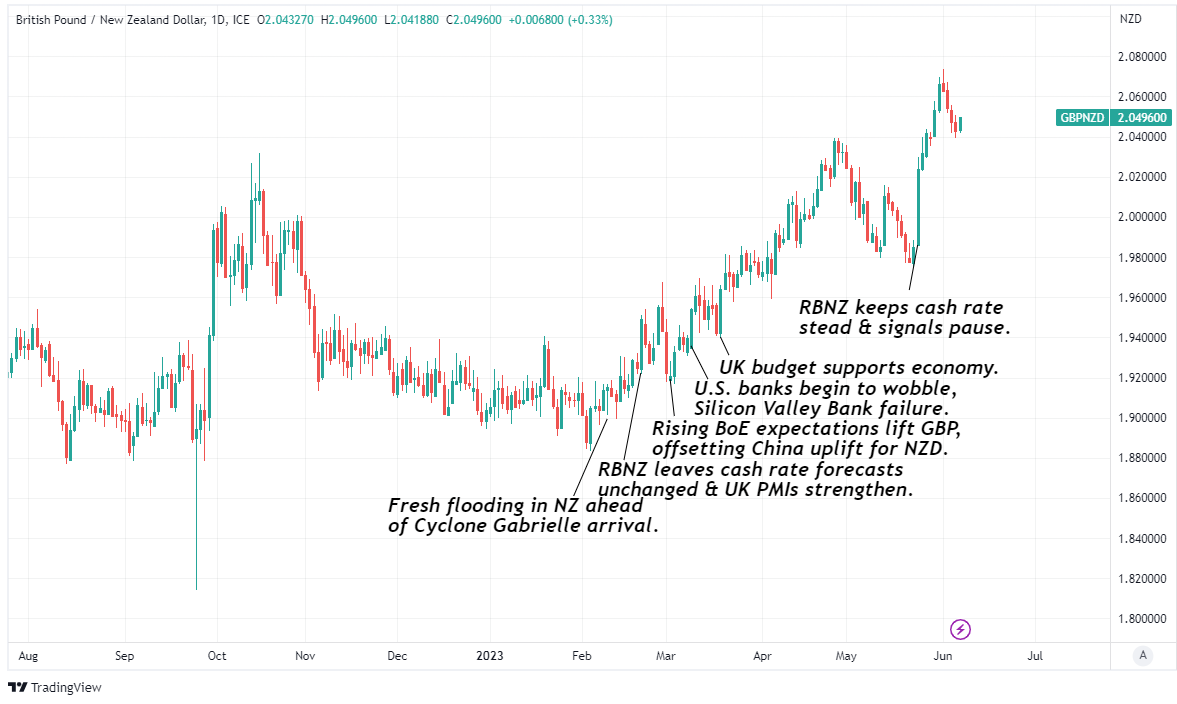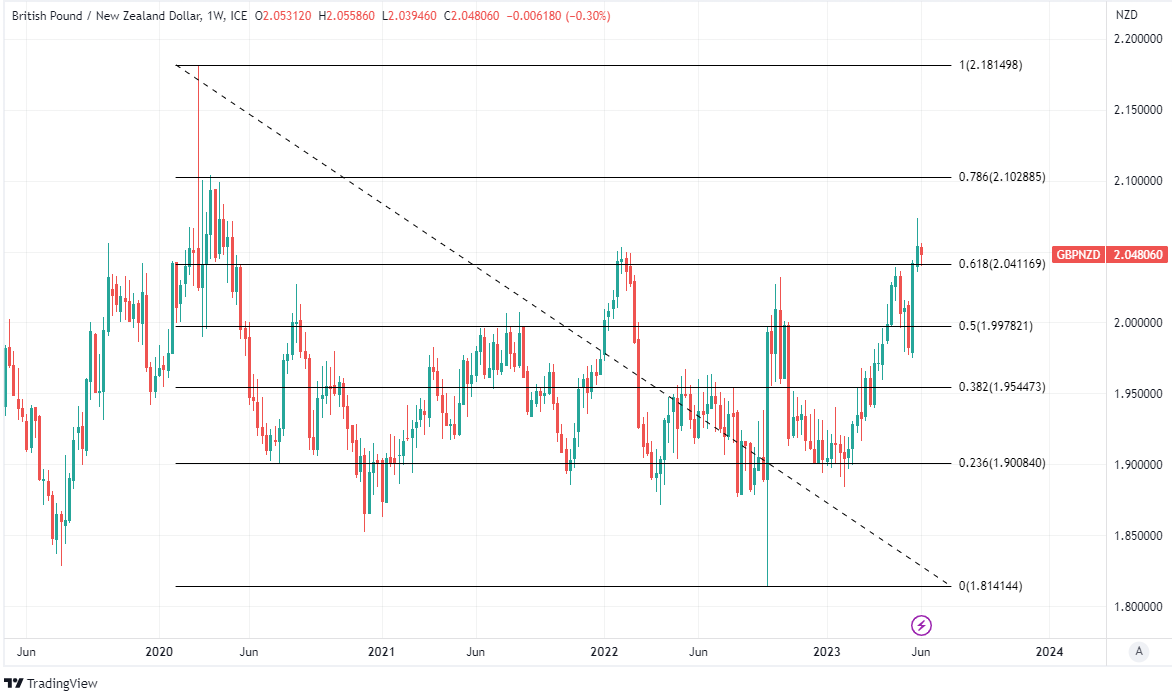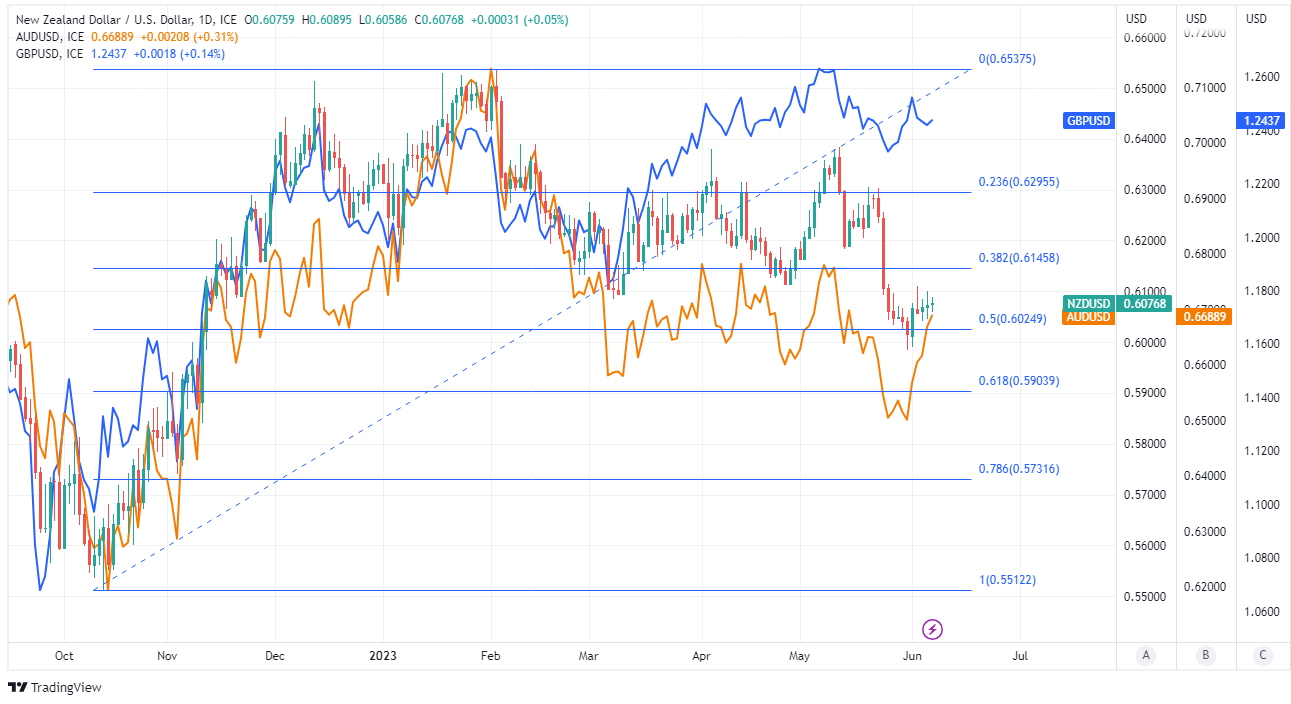New Zealand Dollar Recovery and Economic Data Risks Loom Over GBP/NZD
- Written by: James Skinner
-
"The three major data releases will, in our view, show the impacts of aggressive RBNZ monetary tightening, with much higher interest rates stretching household budgets and weighing on business confidence" - Kiwibank.

Image © Adobe Stock
The New Zealand Dollar has pared away some of its late May losses and could further undermine the bullish trend in GBP/NZD if the Kiwi economy comes across as more resilient than its UK counterpart over the coming week but there are also numerous risks that could yet sustain Sterling near its recent highs.
New Zealand's Dollar has regained some of the ground lost to the U.S. Dollar around the turn of the month to recover an important level on charts in recent days and with its Australian counterpart now also rallying there could be scope for GBP/NZD to further reverse its late May and early June rally over the coming days.
GBP/NZD reached some of its best levels for three years after the Reserve Bank of New Zealand (RBNZ) surprised financial markets by leaving its cash rate unchanged late last month but investor appetite for both currencies is likely to be tested when key economic figures are released over the coming days.
"Neither leg on this cross doing a lot for now, but next week is a big week for UK data, and we get NZ GDP and C/A data then," says David Croy, a senior strategist at ANZ.
Statistics New Zealand's manufacturing sales report is out on Thursday and should provide a partial indication of how the Kiwi economy fared early in the new year but balance of payment figures and the first quarter economic growth number due next week will be much more influential of the outlook for GBP/NZD.
Above: Pound to New Zealand Dollar rate shown at daily intervals with Fibonacci retracements of early March rally indicating possible areas of technical support for Sterling, and annotated for recent events.
The risk is of early February's flooding and cyclone leading the New Zealand economy into a second successive quarter of contraction and a technical recession but RBNZ forecasts suggested growth of 0.3% just last week and the Kiwi Dollar is likely to be sensitive to the actual outcome.
"There’s a chance we get another negative print, and record a technical recession. And even if we see a ‘rebuild’ bounce in Q1, the report will confirm the weaker starting position experienced over the last 6-to-9 months," writes Jarrord Kerr, chief economist at Kiwibank, in a Monday research briefing.
"We then get the next inflation (CPI) print on 19th July, followed by the labour market of 2nd August. The three major data releases will, in our view, show the impacts of aggressive RBNZ monetary tightening, with much higher interest rates stretching household budgets and weighing on business confidence," he adds.
The RBNZ forecast late in May that its economy would narrowly avoid a recession in the opening quarter before succumbing in the second and third to the effects of the more than 500 basis point increase in interest rates announced over the last two years.
But surprise contraction next week would indicate a sooner and larger impact from recent monetary tightening while vindicating the RBNZ for leaving its cash rate unchanged in May but likely at a cost to the Kiwi Dollar that would risk keeping GBP/NZD elevated near its recent highs for longer.
Above: Pound to New Zealand Dollar rate shown at weekly intervals with Fibonacci retracements of 2020 fall indicating possible areas of technical resistance for Sterling. Click for closer inspection.
"The recent solid performance of the pound can be linked with market talk that the BoE may have to raise its Bank rate as high as 5.5%. Market pricing currently puts the peak around 5.15%, which is significantly higher than expectations just a month or two ago," writes Jane Foley, head of FX strategy at Rabobank, in a Thursday forecast review.
"GBP has also found encouragement this year from the better than expected performance of UK growth in recent months. Towards the end of last year the BoE had forecast a five quarter recession starting in Q4 2022. Instead, the UK avoided a technical recession over the winter in part due to a tight labour market," she adds.
Any further gains in GBP/NZD could be limited, however, if next week's employment and economic growth numbers from the UK dampen appetite for the recently popular Pound.
New claims for unemployment-related welfare benefits have surprised on the upside of economist expectations in recent months while the unemployment rate has crept higher and the monthly measure has shown economic growth grinding to a halt.
The performance of the economy has been better than was expected by the Bank of England (BoE) and many others in recent months but the trend has been one of deceleration and further evidence of this next week could see Sterling struggling to remain afloat.
Above: NZD/USD shown at daily intervals with Fibonacci retracements of September 2022 recovery indicating possible areas of technical support for the Kiwi while shown alongside AUD/USD and GBP/USD.
"For now, especially on the higher timeframes, the wind is to the AUD's back, and we see key technical breakouts vs GBP, EUR, and JPY, with AUDNZD having been on a one-way rampage," says Chris Weston, chief market analyst at Pepperstone.
Another potential headwind for GBP/NZD over the coming days is the nascent recovery by the Australian Dollar, which has rallied following a surprise increase in the Reserve Bank of Australia (RBA) cash rate and could help lift the closely-correlated Kiwi at the expense of Sterling if it remains ascendant next week.
Much about the outlook for AUD/USD, NZD/USD and GBP/USD also depends on next Tuesday's U.S. inflation figures and the Federal Reserve (Fed) interest rate outlook announced on Wednesday, however, while the moderating Chinese economic recovery is also a counterbalancing force that could weigh on NZD/USD and support GBP/NZD.
The ebbing recovery of the world's second-largest economy was illustrated again on Wednesday when the Customs General Administration of China announced a reduced trade surplus for May, fueling the softening trend in a wobbling Renminbi while underpinning the greenback and positively correlated pairs like GBP/NZD.
"The May trade figures are the latest in a series of disappointing Chinese economic data and suggest more policy support is required. We consider the reported cut in Chinese banks’ deposit rates will make little difference to the economic outlook and is unlikely to strengthen CNH. The risks are tilted to more policy easing by the authorities that could weigh on CNH, AUD and NZD in our view," says Carol Kong, an economist and currency strategist at Commonwealth Bank of Australia.
Above: NZD/USD shown at weekly intervals alongside AUD/USD, Renminbi-Dollar rate and GBP/USD.
















